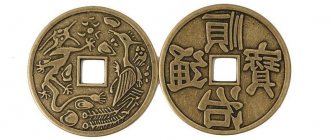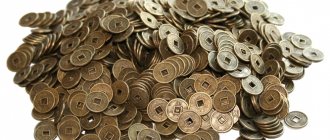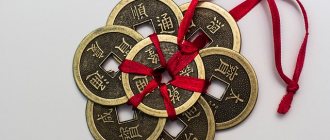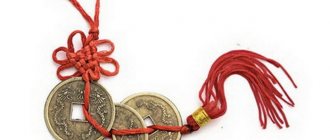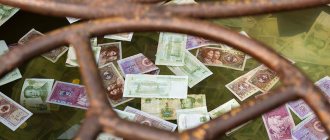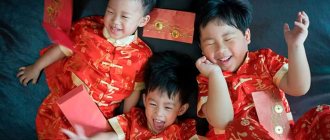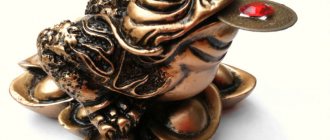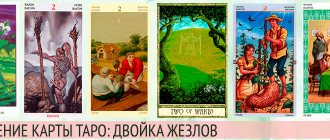Hieroglyphs have always evoked awe and respect. This ancient form of writing even got its name from the Greek ἱ&epsilon,ό&sigmaf, (hieros) sacred and &lambda,ύ (glipho) cut out, carve. That is, sacred carved letters. In an era of general illiteracy, the awe was explained by the fact that scribes were treated as people possessing secret knowledge that could only be shared with initiates. Nowadays, people are so accustomed to letters and the alphabet that it is difficult to imagine that other forms of writing exist. And the mysterious, as we know, attracts.
Now hieroglyphic writing has been preserved only in the Chinese and Japanese languages and is associated with the culture of these countries. You can also mention Korean hancha, but they are extremely rare: the DPRK abandoned them in 1947, and South Korea also almost never uses them. Coins with hieroglyphs in Japan and China are found everywhere, as is everything that contains at least some inscriptions.
Early Japanese coins with hieroglyphs
In Japan, there are also coins with hieroglyphs in circulation. Speaking about the Japanese yen, one cannot fail to mention the history of this country, divided into periods:
- Meiji: from 1868 to 1912
- Taisho: from 1912 to 1926
- Showa: from 1926 to 1945. Pre-war and war periods.
- Showa: from 1945 to 1989. The period of occupation and the post-occupation period.
- Heisei: 1989 to 2021
- Reiva: 2021 to present.
The yen appeared at the very beginning of the Meiji era, between 1868 and 1871. The first coins were made from gold and silver.
The photo above shows 1 yen from 1870. It is immediately noticeable that this coin has a flower and hieroglyphs without numbers. How to determine its denomination? The fact is that there are still numbers here, but not the Arabic ones that we use, but Chinese ones. Below along the edge, from right to left, you can see the inscription separated from the others by dots: 一圓. This hieroglyph: 一 - and means the number 1. The next sign following it is the yen symbol. The same is with the year of manufacture, it is present here. On the right along the edge you can see the inscription: 明治三年. Literally it translates as: 3rd YEAR OF MEIJI. The chronology in Japan is not based on the Gregorian calendar, but from the beginning of each era. Thus, the year 1868 is designated here as the 1st year of the Meiji era, 1870, respectively, as the 3rd. A dragon is depicted in the center of the obverse. The reverse features a chrysanthemum flower, symbolizing the sun and the power of the emperor.
Japan was also familiar with Arabic numerals during the Meiji era. The photo above shows 20 sen from 1873. A sen is one hundredth of a yen, just like a kopeck in Russia. The coin with a flower and hieroglyphs on the reverse also has Chinese numerals. Under the already mentioned chrysanthemum, from top to bottom, there is an inscription: ニ十銭, which translates as 20 SENOV. On the obverse, along the bottom edge, you can see 20 sen in English: 20 SEN.
China issues silver bullion coins with dragon
LPM delved into Asia's numismatic past with the release of the eight-round Dragon Dollar series. The series debuted last year and is now coming to an end. However, fans of the cycle will be pleased to see a new format joining the ranks of the dragon dollars - a kilogram bullion coin made of silver.
This series is really worth paying attention to. It goes back to the period when trade dollars were the universal unit of exchange for commerce in many countries around the world. The silver dragon was produced in various forms in Korea, China and Japan and in many cases acquired a local flavor.
This re-release of the kilogram version is a good example of this. Jiang Nan Province, which literally means "south of the Yangtze River", was one of the richest regions of China, and the mint located there (originally called the Nanjing Mint) began minting silver coins in the late 1890s. They were not produced for long, only a few years, so they are now very expensive on the collector market. The Jiangnan Dollar (7 Mace 2 Candareens) is one of the most popular ancient Chinese coins, and now it has been brought back to life as a kilogram version. The incredibly beautiful LPM coin is reminiscent of Imperial China with its unique style.
Investment coins, weighing 1 kg with a diameter of 50 mm, are made of silver with a purity of 0.999 using Brilliant UNC technology.
The new kilogram version retains the traditional design, it just became larger. Judging by its beautiful appearance, it is closer to a collector's version than an investment version.
In 1897, the Heaton Mint in Birmingham developed the original dies for a series of silver denominations for a Chinese company in Jiangnan. The obverse features the iconic Chinese dragon curled into an S shape, releasing a fireball from its mouth. On the reverse, in the center of a circle of tiny capital “S”, there are 4 Chinese and 4 Manchu characters that read “Kuang Xiu Yuan Pao”.
Bullion coins not intended for the mass market will be issued in a quantity of 100 copies. Each copy is presented in a wooden box with a certificate of authenticity. For the first time, Chinese manufacturers will laser engrave the year, weight, mintage and fineness on the rim of coins. The revived classic will be a bright addition to any collection!
Japanese coins before the end of World War II
During the subsequent Taisho and Showa eras and until 1945, Japanese coins did not change much. In the photo above you can see 50 sen, which does not contain Arabic numerals. On the obverse in the center you can see the same chrysanthemum flower. Along the edge there are inscriptions in Japanese, on top: 本日大 - GREAT JAPAN, below: 昭和十一年 - 11TH YEAR OF SHOWA, that is, 1936 according to the Gregorian calendar. On the reverse there is a chrysanthemum flower on top, 50 sen on the bottom in Chinese numerals: 五十銭. To the left and right of the inscription are two doves, symbolizing longevity.
Coins with a hole: history and modernity
As you know, Chinese civilization gave the world many useful inventions - gunpowder and a compass, printing and paper, this is not a complete list of discoveries made on the banks of the Yangtze and Yellow River.
And few people know that completely independently and much earlier than in Europe, money appeared in China in the form of metal circles, which we now call coins. If in Europe the first coins appeared at the beginning of the 7th century. BC. and were minted from electrum (a natural alloy of gold and silver), the first Chinese coins were produced by casting bronze in stone or ceramic forms back in the 11th century BC. AD in the kingdom of Western Zhou. Currently, several coins are known with hieroglyphs denoting this kingdom.
The oldest Chinese coins. Kingdom of Western Zhou. Bronze. Drawing from the monograph by A.A. Bykov. Coins of China. – 1969
But Chinese money had an amazing feature: it had a hole. On Western Zhou coins it could be either round or square. Later, a standard was assigned to all Chinese coins for two and a half millennia - a bronze circle with a square hole in the center. This standard was finally established by Emperor Wu Di (Han Dynasty) in 118 BC.
5 shu. 118 BC Han Dynasty. Drawing from the monograph by A.A. Bykov. Coins of China. – 1969
It was then that a coin with a face value of 5 shu appeared, which became a model for many centuries. The oldest Chinese coins indicated the weight of the metal, the denomination or the city where the coin production took place, and in some cases both.
The lower part of a ceramic mold for casting 5 shu coins. First centuries AD. Shanghai Museum
Three years after the accession of the first emperor from the new Tang dynasty, namely in 621, a significant event occurred in China that influenced the entire history of numismatics both in China itself and throughout Southeast Asia. In this year, a coin with a hole in the face value of one qian was issued.
Qian. 620s. Tang Dynasty. Drawing from the monograph by A.A. Bykov. Coins of China. – 1969
The obverse of the Qiani depicts four hieroglyphs, one on each side of the hole, meaning “circulating coin of the beginning of the reign.” The reverse of these coins is usually smooth.
Chinese hole coins became the model for coin production in Korea, Vietnam, Japan and other countries in East and Southeast Asia.
Vietnamese coin of Chinese type. Kan Hung (1740-1787). Dragon in the clouds. Bronze
Thus, coins with a hole can be safely added to the list of inventions of Chinese civilization.
What was the hole in the center of the coin intended for? The answer is simple - for convenience of calculations. Since all coins with a hole until the twentieth century were cast or minted from bronze, and not from gold and silver, their face value was relatively low. Accordingly, payments in large amounts required a large number of coins - hundreds, and sometimes thousands.
A 19th-century drawing shows a Chinese man holding a bunch of coins. Drawing from the monograph by A.A. Bykov. "Coins of China". – 1969
For convenience, a certain number of coins were strung on a cord or metal rod. Such coin bundles were a means of payment for large sums of money.
Coins from the Qin Dynasty (1644-1911) strung on a metal rod. The number of coins in a bundle is 27 pieces. Height – 9.5 cm, weight – 360 g
After the overthrow of the Emperor in 1911, the Republic of China completely abandoned the minting of hole coins and switched to European coin production standards.
But Chinese civilization has always, willingly or unwillingly, shared its achievements with the rest of the world. So coins with a hole spread not only in space, but also in time. Korea, Vietnam, Japan, Laos, Thailand adopted the Chinese coin design. Hole coins were minted by European colonialists for their overseas possessions in Southeast Asia. A number of European countries still issue similar coins. Whatever you say, tradition is a terrible force.
Here are the coins of medieval Japan - mon. Only a specialist will distinguish them from Chinese ones.
1 mon. Kan'ei tsuho. Second half of the 17th century
Under the Tokugawa shoguns (early 17th century), Japan finally centralized the monetary system. The casting of bronze coins in denomination of one mon began (from 1626), weighing 3.3 g. The coin is known by the motto depicted on it - Kan'ei tsuho (the third year of the reign of Emperor Go-Mizunoo) - 寛永通寳. Coins of this type were issued until until 1870.
In the mid-1830s, Japan issued very interesting coins with an unusual oval shape.
100 mon. Tempo tsuho. Japan. 1830s
These wonderful coins are called Tempo tsuho (Japanese: 天保通寶) - “Tempo reign period”. The denomination of Tempo tsuho coins was 100 mon.
Japan abandoned the casting of coins and finally switched to European coinage principles in the second half of the 19th century.
A gear-shaped hole on a 1979 5 yen coin. Emperor Hirohito. Mint in Osaka. Brass
50 yen 2005. Emperor Akihito. Mint in Osaka. Cupronickel
However, in the Land of the Rising Sun, the tradition of minting coins with a hole continued into the 20th century. It remains the same today: some denominations continue to be issued with the traditional hole in the center.
1 satang. Siam (Thailand). King Rama VIII (1935-1946). Year 2484 according to the Buddhist calendar (1941). Bronze
At a time when Asian countries were gradually abandoning the minting of coins with a hole, in Siam (the old name of Thailand) under King Rama V in 1898, the production of satangs (1/100 baht) - small change coins with a hole - began. At the same time, a decimal monetary system was established in the kingdom. Currently, Thai coins do not have holes.
As already mentioned, in the 19th and 20th centuries, European colonialists issued a variety of denominations of coins with a hole for their overseas possessions. Sometimes, the urgent need for cash led to funny things. So in 1875, after the capture of the southeastern part of the Indochina Peninsula and the formation of the French colony of Cochin, the production of coins with a hole was established for the needs of monetary circulation.
1 sapek, converted from French centime. 1875 Colony of French Cochin
The problem had to be solved quickly, and the metropolis did not come up with anything better than to take the French regular coin of 1 centime minted by Bordeaux, and at the French military arsenal in Saigon they simply punched holes in them. Thus, with a “light movement of the hand,” the French centime turned into the Cochin sapek. A simple manipulation was required so that the local population, accustomed to Chinese-type coins, would easily and willingly accept the new money.
Hole coins were minted for numerous colonies by the largest colonial empire in history - the British.
1 cent. British East Africa. 1951 George VI. Bronze
1/10 penny. British West Africa. 1944 George VI. Cupronickel
1 penny. British colony of Rhodesia and Nyasaland. 1955-1963 Elizabeth II. Bronze
London issued coins with a hole for British East and West Africa, Rhodesia and Nyasaland, and for the “diamond in the crown of the British Empire” - India.
1 cent. Dutch East Indies. 1937 Utrecht Mint. Bronze
Holland did not lag behind its colleagues in oppressing and exploiting the colonies, issuing coins with a hole for the colonies in the East Indies (islands of the Malay Archipelago and the western part of New Guinea).
What motivated the European colonialists? Numismatic historians give two reasons. Firstly, Europeans adapted to the coinage traditions of enslaved peoples and states. Secondly, the coins of the colonies had to be different from the coins that were in circulation in the metropolis. Therefore, holes were punched in the coins, or the coin itself was irregular in shape (with a wavy edge, etc.).
The colonialists can be understood, but for what purpose some countries of the world, not related to countries with the Chinese monetary tradition, issue coins with a hole even today is not entirely clear. Perhaps a banal saving of metal?
10 lept. Greece. 1912 Nickel
20 fillers. Hungary. 1941 Coated steel
2 zlotys. Poland. Commemorative coin. 2003 Brass
1 crown. Denmark. 2007 Copper-nickel alloy
Our journey into the history and modernity of hole coins has come to an end. Having appeared in Ancient China 3000 years ago, these numismatic monuments turned out to be very “tenacious”. Many countries around the world still do not intend to give up minting such items. And numismatists have collected and continue to collect thematic collections in which the main character is a coin with a hole.
Roman Novozheev
Candidate of Historical Sciences, Associate Professor
Description of coins
Chinese coins are round in shape and have a square hole in the middle. The active side signifies yang energy and always contains four characters. The passive side, responsible for yin, has two symbols.
Typically these coins are made of copper. Some of them have distinctive features in the form of specific images. It could be a sword, a dragon, a phoenix. Such coins are designed to protect a person from evil forces.
Two sides of a Chinese coin with a square hole
Other types of Chinese coins
It is customary to carry a coin with two dragons in a pocket or purse and hide it under the mattress. It is used to attract love and maintain harmony in marriage.
Copper money with the image of Shou Sin will help improve your health. Often storks, deer and peaches are drawn on it, and on the other side there is a hieroglyph meaning longevity.
A specimen with five bats is considered rare. Such a talisman is designed to provide its owner with strong protection and support.
A large Chinese coin with a square hole and the image of Zhong Li Quan is a powerful amulet. It is hung in the house in the assistants' area or carried with you.
Before using coins, it is important to clean them of foreign energy and soak them in salted water for three days. In this way, you will be able to activate the wealth sector and attract success and prosperity into your life.
How many coins should there be?
You can use one or more coins as a money talisman. The quantity should be chosen based on the purpose and situation:
| Number of coins | Properties | How to use |
| 1 | Attracts wealth | You can hang it on the front door handle, after tying a red thread on it, or put it under the rug, in a folder with documents |
| 2 | Symbolize the accumulation of finances, protect from evil | Must be carried with you or put in your favorite box |
| 3 | Attract financial well-being from three sources at once | Can be placed on the wall, placed under a money tree or buried in a plant pot |
| 5 | Increase the income of trade workers | It is recommended to place it under the door mat |
| 6 | Represent heavenly luck | The best place for storage is the north-west of the room |
| 8 | Attract wealth into the house from all sides | It is recommended to locate it in the south-eastern sector of the home |
| 9 | They attract wealth not only to the owner, but also to all his descendants of the next 9 generations | Coins from the Qin Dynasty are suitable, they are placed in the southeast and northwest of the house |
The numbers 4 and 7 are considered unlucky. This number of coins is not suitable as a talisman.
Expert opinion
Melnik Dmitry
feng shui master
Risky people who bet money on races or like to play the lottery need to keep a Chinese coin in the southeast of their home near the door. It can also be worn around the neck by passing a red string through the hole. Such a talisman will attract good luck and make sure that fortune does not turn away from a person.
It is not necessary to put Chinese coins on public display. They can be hidden from prying eyes so that others do not ask many questions.
